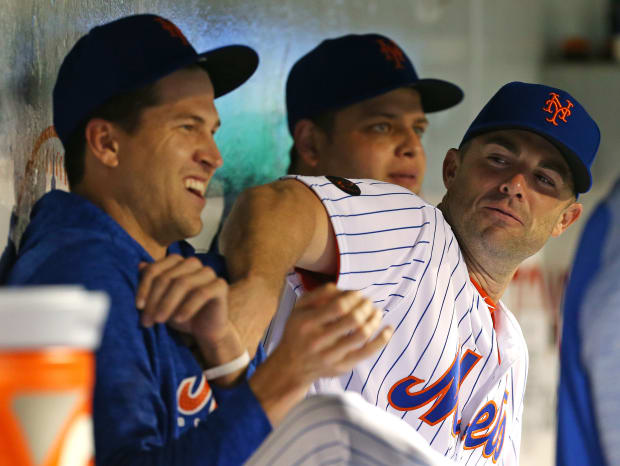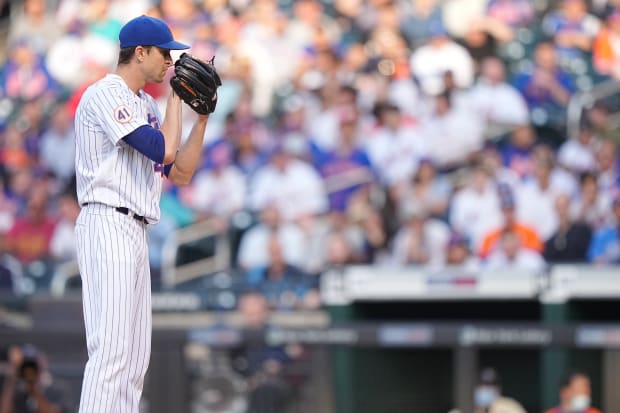As the executive director of the Mets’ Florida facility, Paul Taglieri works through a list of duties longer than the line at the Citi Field Shake Shack. He oversees the grounds crew. He fixes anything that breaks. He distributes hats to the janitorial staff. One thing he does not do anymore, though, is escort the major league team onto the field for spring training games.
He had to give that up a couple of years ago, because the team’s ace would not stop ambushing him in the dugout and pouring a cup of water on his crotch. “So it looked like I urinated on my pants,” Taglieri says. “And then I had to walk around the stands with 7,000 people.”
Once, he thought he had eluded Jacob deGrom. Then Taglieri ducked into the tunnel that leads back into the clubhouse. “And he’s standing there with the hose hooked up to the sink, and he just crushes me,” says Taglieri. So now one of his underlings starts the game, while Taglieri hides in the stands and communicates with her by radio.

Adam Hunger/Getty Images
When he’s not tormenting opposing hitters, deGrom likes to torment the people closest to him. “I would be like, ‘Read the handbook! This is bullying! I’m gonna call HR on you,’” Taglieri says, laughing.
Catcher James McCann likes to say that deGrom doesn’t just want to beat you; he wants to embarrass you. For the most part, he succeeds: He won back-to-back National League Cy Young Awards in 2018 and ’19 and he has received votes four other times. Hitters celebrate making contact against him. No other starter throws so hard so often. (He has hit 99 mph 671 times since ’18. The No. 2, Gerrit Cole, has done it 126 fewer times in 205 more innings.) Remarkably, and much to the chagrin of his opponents, deGrom has added velocity with age: His four-seamer averaged 94 mph in ’16 and 99 mph in ’21.
“I don’t know where he’s getting it, but it’s pretty ridiculous,” says Dodgers All-Star shortstop Trea Turner, who faced deGrom 45 times as a National and amassed an OPS of .608. “It was a tough at bat at 94, and it’s not fun at 100. It’s a little bit annoying.”
Last season was on pace to be deGrom’s masterpiece: He carried a 1.08 ERA and a 0.554 WHIP into early July, and he induced a swing and miss on nearly a quarter of his pitches, more even than the most dominant relievers.
But then a forearm strain became elbow inflammation became the end of his season, a year after neck, back and lat injuries limited him to 68 innings in the COVID-19-shortened season. He insisted this spring that he was ready to make 30 starts this year, but after two spring training appearances, he was shut down with a stress reaction in his right scapula. He hit 101 mph during his first two rehab starts, in early July, then after his third the Mets announced he felt mild muscle soreness and pushed his next outing back two days. The world has staged two Olympics since deGrom last threw a major league pitch. If nothing else goes wrong, he is scheduled to make his season debut next week in Washington.
He declined to be interviewed for this story, but at a news conference this spring, he was asked whether he is confident he can continue to throw hard and stay healthy. “Yeah, I think so,” he said.
He would be the first. The pitchers clustered beneath him on that list of fireballers also dot the injured list: Angels righty Noah Syndergaard, who had Tommy John surgery in 2020 and has appeared in 17 games since; Red Sox righty Nathan Eovaldi, who had Tommy John surgery for the second time in ’16 and twice since then has hit the 60-day injured list with loose bodies in his elbow; Yankees righty Luis Severino, who had Tommy John surgery in ’20 and has pitched in 23 games since ’18. deGrom had Tommy John surgery in ’10, after his first season in rookie ball, and he turned 34 in June. And during that same news conference, he said that after this season, he plans to exercise the opt-out in the five-year, $137.5 million contract extension he signed in ’19. He added that he hopes to remain a Met.
Even without him, New York pitchers are embarrassing hitters. The rotation, bolstered by newcomers Max Scherzer and Chris Bassitt, is striking out more than a batter per inning, the second-best figure in the sport. Closer Edwin Díaz is whiffing 51% of the men he faces, the second-best mark in history. The Mets have the second-best record in the National League. But Atlanta sits only three games back, and the trade deadline looms. So in what could be their ace’s final season in Queens, the Mets will have to answer a question: deGrom bullies friend and foe alike. Can he bully his own body?

Rich Schultz/Getty Images
At his lowest point, David Wright turned to his friend. Thirteen months after being diagnosed with the spinal stenosis that would eventually end his career, the Mets’ captain underwent a procedure to repair a herniated disc in his neck and fuse two of his vertebrae. His 2016 season was over. His career was in doubt. He was confined to a neck brace and forbidden to drive. Still, he wanted to show up at Citi Field and cheer on his teammates.
So he asked deGrom, then New York’s lanky 28-year-old No. 3 starter and Wright’s neighbor in a Lenox Hill high-rise, to ferry him to the ballpark. Typically when they carpooled, Wright drove, because, he says now, deGrom exhibits “zero” regard for the speed limit. “You’re just nauseous,” Wright adds. “I did everything I could to not get into a car with him.”
So he gave the kid a talking-to. “Jake, in all seriousness, I need you to drive carefully,” Wright said. “I can’t take your driving thing.”
deGrom agreed. Then he swung onto the FDR Drive, turned on his hazard lights and made the trip at 10 mph. Other drivers honked and flipped them off as they blew by. Wright just rolled his eyes.
“He’s getting the biggest kick out of it, because he’s making fun of me,” he says.
deGrom’s eyes light up when a teammate enters the clubhouse wearing unfashionable shoes. He once watched Syndergaard struggle to balance on a bosu ball; the next day, players walked into the training room to see deGrom standing serenely—and pointedly—atop it. Another time, after a string of interviews during Pete Alonso’s Rookie of the Year season, deGrom turned to the kid. “It’s the New York Mets,” he said. “Not the New York Petes.”
He intimidates younger players and peers alike. “When I first showed up, for probably the first two years, three years, it was like, I don’t know if you’re my friend or if I should be deathly scared of you,” says center fielder Brandon Nimmo, who has played with deGrom since 2016. “It’s kind of both.”
deGrom enjoys keeping people off balance, both at the plate and in the clubhouse. Sometimes he will ask new members of the organization startlingly personal questions, just to see how they react. “He’s testing you,” veterans explain.
And it’s hard to be sure of his mood. “You walk up to him, and he looks like he wants to choke-slam somebody,” says Ricky Meinhold, who was a pitching coach in the Mets’ organization from 2019 through ’21. “And then he’ll change that thought and say, ‘Hey, Ricky, how ya doing?’”
Some of this behavior may seem mean. People close to him insist they cherish it. “He’s not a bad guy,” Nimmo says. “He’s a really good guy. He will throw some pranks out there, he can throw some one-liners at you, but it’s all in good fun.”
Indeed, sometimes the hassling feels more like an honor. Meinhold can’t quite decide how to feel about the fact that he eluded deGrom’s pranks.
“I’m lucky, I guess,” he says. “Well, I guess not, at the same time, because the people that he does do those things to he absolutely adores, whether he'll say it or not.”
deGrom learned from the best: Wright was the team prankster for most of his career. He, too, targeted Taglieri, once having his car set on cinder blocks and the tires distributed throughout the stadium—one on Taglieri’s couch, one among fans on the berm in the outfield, one in a pitching machine in the batting cage, one on a backfield.
At first, deGrom was the victim of Wright’s sense of humor. For the first three years of his career, any time deGrom piped up, Wright and bullpen catcher Dave Racaniello would round on him. “Weren’t you in Triple A, like, six months ago?” they’d ask him. Wright would challenge deGrom to games of pluck and then beat him so badly deGrom would throw his cards in the air.
As a rookie, deGrom once made the mistake of laughing when a teammate made a joke at the captain’s expense. So Wright grabbed a pair of scissors and turned his jeans into jorts. “You could almost see a little bit of buttcheek,” says Wright, clearly still delighted with himself. “We paraded him around the hotel.” (Wright adds that he paid for a replacement pair.)
But soon they realized they were better as a team. One day Taglieri walked into the facility to find that the lock on his office door had been changed. Wright and deGrom finally gave him the key … and watched, cackling, as he realized they had paid someone to come in overnight and erect drywall inside so that the office was now two feet wide by two feet long. The walls were painted; Taglieri’s family photos hung on hooks.
“I can’t get to them, because they tell me, ‘We have a lot of money, and we have a lot of time. You’ll never get even,’” Taglieri says.
The Mets still speak with awe of one of the few people to pay deGrom back. Former assistant hitting coach Pat Roessler, quite reasonably, “wasn’t crazy about rats,” says Nimmo. So during a series at Fenway Park when the team spotted a rodent in the dugout, deGrom spent the night touching Roessler lightly on the shoulder with a wrapper and rolling small objects by his feet.
Later, deGrom returned to the clubhouse to find his street shoes nailed to the floor of his locker.
“That was pretty good,” says Red Sox catcher Kevin Plawecki, who played with deGrom from 2015 through ’18. Plawecki has his own victory story: He once sprinkled Hi-C drink powder in deGrom’s cleats before a workout. When deGrom took off his socks, he realized his sweat had combined with the powder to stain the soles of his feet beet red.
“But you gotta be careful,” says Nimmo, “Because Jake doesn’t stop.”
Often, during spring training, deGrom throws an early bullpen session and finds himself at the complex with nothing to do. He waits for Taglieri to leave his office, then gets to work. Some days deGrom turns everything upside down: desk, desk chair, end tables, golf clubs. Sometimes he swipes Taglieri’s car keys and moves his car across the parking lot.
In 2019, on the last day before the team began renovating the Port St. Lucie facility, deGrom wandered casually into Taglieri’s office and picked up a golf club.
“What are you doing?” Taglieri asked warily.
“I think I’m going to start the construction now,” deGrom said, and slammed the club through the wall.
“He does not apologize,” says Taglieri, laughing. “I’m not afraid of David [Wright]. I’m afraid of Jake.”

Jim McIsaac/Getty Images
deGrom fears no one. He is the best athlete most of his teammates have ever seen, and he likes to remind them of that. He can dunk a basketball while wearing dress shoes. Racaniello believes he could have been a high-level wide receiver. (“I gotta bring him down,” he says. “I always give him a hard time, ‘We don’t know if you can take a hit!’ He’s like, ‘I can take a hit.’”) Wright once watched deGrom walk across a gym on his hands.
Second baseman Jeff McNeil, when asked what opponents say about deGrom’s stuff when they reach second base, identifies a problem: They don’t reach second base.
And deGrom is competitive to the point of absurdity. He stages one-man races off the field after shagging fly balls. When teammates’ elementary schoolers want to toss around a Nerf football, he pegs them with it. He insists on taking grounders at shortstop, and he keeps track of how many errors everyone makes. “After he beat you in sprints,” Wright says, “he’d give you a head start and beat you again.” Coaches say they breathed a sigh of relief when the new collective bargaining agreement introduced the universal designated hitter; deGrom kept hurting himself swinging too hard. Teammates say they rarely see deGrom happier than when he has humiliated an opposing hitter. “That brings him a lot of pleasure, knowing that guy’s got no chance,” says McCann.
Even as a child growing up in De Leon Springs, Fla. (population: 2,840), deGrom was something of a thrill seeker. He likes to tell teammates about the days when he and his friends got hold of an excavator, drove it to the shores of a lake, tied a rope to the arm and swung the joystick back and forth, flinging themselves into the water. When he and Cardinals lefty Steven Matz played together in the minor leagues, they would make an annual pilgrimage to deGrom’s DeLand, Fla., ranch before the season began and race four-wheelers through the property. “Reckless activities, we used to call it,” Matz says, laughing. “Not anymore,” he adds. Even now, deGrom wakeboards whenever he gets the chance, recording videos of himself flipping over waves. Racaniello says deGrom credits the extracurriculars with helping him increase his velocity as he ages.
“I’m not trying to get him in trouble, based on contract stuff,” says retired utilityman Kelly Johnson, who played with him in 2015 and ’16 and remains one of his close friends. “But if he was not playing baseball, it would be crazy to know what he would be doing to his body.”
Until the Mets allow him to take up skydiving or fight Jake Paul, deGrom finds other ways to indulge his inner child. “Every time I talk to him,” says Johnson, “he’s buying some old, beat-up truck. It’s like, how many of these do you need?” Many athletes treat their body like a temple. deGrom treats his like a Taco Bell. “I’ve never seen somebody so in shape drink so many Mountain Dews,” says Wright. When the team nutritionists banned the junk food he prefers to wolf down before his starts, deGrom sent a clubhouse attendant to the concourse to fetch him a burger and fries.
All this might seem an uncomfortable fit for a professional athlete. But no one much cared what deGrom did to his body as long as it was producing 200 innings of sub-2 ERA. Indeed, this spring, before deGrom went down, pitching coach Jeremy Hefner insisted the team trusted its ace to do what made sense for him.
“I don’t pay too much [attention]—like, I’m very concerned about what they do on the field, and obviously what they do off the field translates over to that,” Hefner said. “But if a guy wants to have a burger, he can have a burger. If a guy wants to not have a burger, then don’t have a burger.” He added, “I’m not any more concerned about him than I would be about anyone else.”
Four months—and one injury—later, Hefner says his opinion has not changed. “Pitchers do an unnatural thing by throwing overhand, and we can try to fix mechanics and all those types of things, and sometimes guys just break,” he says. He adds that the length of deGrom’s ramp-up—his first rehab start came on July 3, so he will have spent just about a month in the minors—is an indication that the Mets are trying to give him every possible chance to stay healthy going forward.

A common refrain about deGrom is that he knows his body. “He’s one of the best I’ve seen at making adjustments on the fly,” says McCann. “A lot of guys have to go watch video. He watches video, but he’ll tell you in the moment, ‘My release point’s lower,’ or ‘My release point’s a little higher,’ or whatever. He can feel that. And usually he makes the adjustment.”
Hefner says, “I think Jake’s just naturally gifted with how he understands where his body is in space really well. So whether it’s playing Ping-Pong or he’s taking ground balls or he’s throwing a pitch or whatever, he has a really good understanding of where his body is in space, and that helps him, and then he’s also blessed with height and flexibility and the ability and rhythm.” Hefner adds that deGrom’s background—he came up as a shortstop and did not pitch regularly until his junior year at Stetson—means he has less mileage on his arm than most of his peers. If anyone is to defy the aging curve, Hefner says, he would bet on deGrom, “100%.”
And he puts in the work. The weight room at the Mets’ spring facility overlooks the 10 bullpen mounds; when deGrom throws, his teammates gather at the window to watch. “He cares so much about his craft,” Wright says. “I think he picks up a baseball almost every day in the offseason and throws with his dad. For all the goofiness and all the pranks, you’ll see him in the mirror in the gym, repeating his delivery. You’ll see him in the video room, trying to pick up things he’s doing right and wrong. He’s a master of his craft, and I think other people see that, and they can learn a lot from it.”
Racaniello marvels at the care deGrom dedicates to his bullpen sessions. Each delivery is the most important thing he will do that day. He might take half a minute between pitches, so engrossed is he in every one. “I don’t know if there’s anyone that focuses more in a bullpen,” says Racaniello. “He’s always been that way.”
Meinhold says he will never forget his first impression of deGrom, which came when he silently watched one of the ace’s bullpens. “When he got on the mound to get his work in, it was locked in,” he says. “Like locked in, like the ultimate locked in. You could just see it from his mannerisms, from his attention to detail in how he comes set, how he focuses with his eyes, how he takes his breath, how he delivers the pitch. Everything was so under control and with a purpose. And I say these things and somebody reading it would be like, ‘Yeah, he’s a major league pitcher, obviously,’ but that’s not the same with everybody. And if you’re in the game, and you’re around those types of athletes, you know, there’s a handful that are very, very good at it and then there’s the guys that are even better at it or are more crisp with it. It’s not so common. I know that every time he does his touch-and-feel sessions during the week, it’s a certain amount of pitches every single time, no matter what. When he [throws] his bullpen, it’s the same amount of pitches every single time, no matter what. And when he plays catch in the outfield, it’s roughly around the same range every single time. That’s not normal.”

Erick W. Rasco/Sports Illustrated
Little about deGrom is. His career to this point is unprecedented. So is his career moving forward. His future in New York is uncertain. As his teammates have forged this unifying season, he has followed along from his home in Florida. For much of the spring he did not have a locker at Citi Field; when he did, it was empty. He is around little enough that new manager Buck Showalter, when asked about what to expect from him when he returns, recently remarked to reporters, “Y’all know him better [than I do].” How well Showalter will get to know him is an open question. At least one Met has begun to wonder whether deGrom will return this season at all.
Despite deGrom’s inactivity in 2022, his market figures to be robust this coming winter if he maintains his promise to opt out. Syndergaard received $21 million from the Angels after making two starts in ’21. Justin Verlander fetched $25 million from the Astros after making zero. deGrom should top them both—and could top Scherzer’s record $43.3 million average annual value.
When he takes the mound, no one bullies hitters like deGrom. After this season, maybe he will bully an owner or three into bidding for his services. It’s not usually wise to bet against him.
“He doesn’t want to get beat by anybody in baseball,” says Plawecki. “[Or] in life in general—going back to messing around in the locker room, he always wants to have the last laugh. And most of the time he does.”







